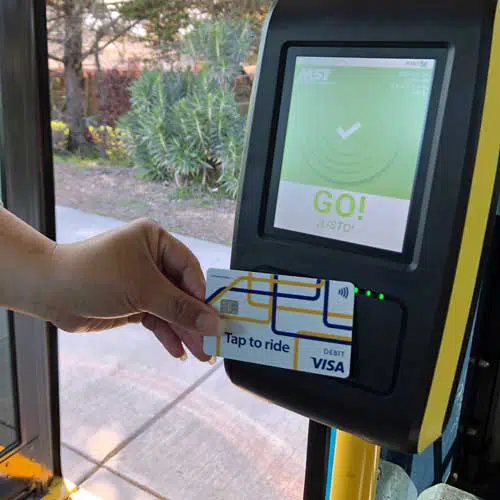As the veil of the Covid-19 pandemic begins to lift, consumers are beginning to resume some of their daily activities. One is returning to the office. While not all are doing this yet, the expectation is that mass-transit systems will soon see ridership bloom. One indicator is that Visa Inc. is supporting more than 700 active projects that will include open-loop payments, says Jason Blackhurst, Visa senior vice president of innovation and strategic partnerships.
The most recent instance was the deployment this week of a Visa-compatible tap-to-pay service with the Monterey-Salinas Transit agency. Bus riders can pay fares by tapping a contactless device on the vehicle without needing to purchase or load a separate transit card or handle cash. The California agency is one of five to accept tap-to-pay for fares in the United States, the card brand says. Visa already has helped more than 450 similar transit projects around the world.
These projects bode well for adding electronic payments to transit programs, especially following the pandemic. In some areas, ridership dropped 80%, Blackhurst says. Now, as the pandemic’s effects start to dissipate, ridership volume is beginning to build again, but the use of contactless for transit is building even faster, he says. In some instances, ridership might be returning to 40% of the pre-Covid volume, but the use of contactless was at 80%, Blackhurst says. In New York City, for example, ridership is still below pre-Covid levels, but contactless use is above them, he says.

Transit has always been viewed by all four U.S. card brands as a primary catalyst for contactless adoption. And while contactless use in general grew slowly prior to the pandemic, its use has surged in the past year or so. For transit, Blackhurst suggests its use may have been boosted by consumers wanting to avoid using cash and not wanting to touch payment kiosks. And some commuters, used to perhaps buying monthly passes, now purchase single-use tickets for infrequent trips to the office.
Visa’s data also shows that in countries where contactless payment already was popular, contactless cards dominate for transit payments now. In other countries, where contactless use was less mature, such as the United States, mobile wallets are gaining favor, Blackhurst says.
Eventually, individuals will commute to work again, Blackhurst says, though their travel patterns may be different from pre-2020. “It’s going to evolve,” he says of transit use. While buses, trains, and subways may be what it means to commute now, that could change. “We think municipalities will look at how to make this easier for consumers,” he says. “The question is what is the new normal? We know that mass transit will be very important.”





